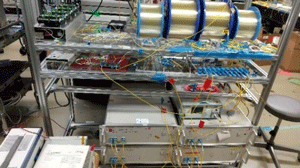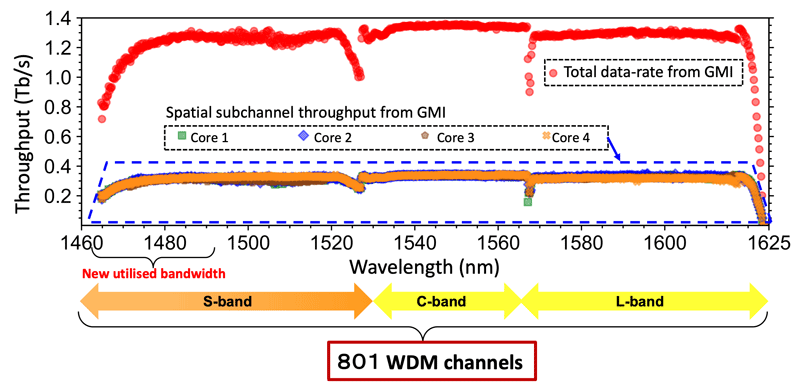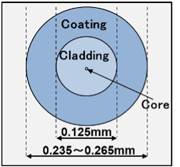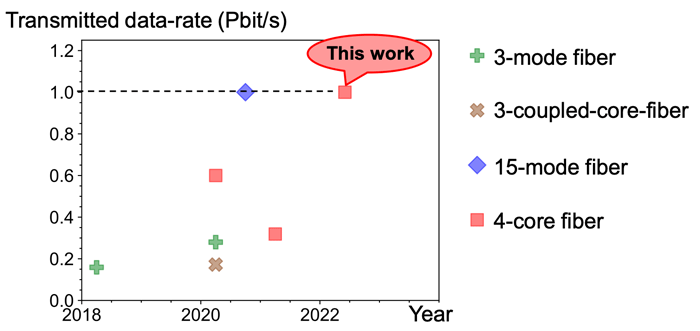Highlights
-
1 petabit per second transmission capacity demonstrated in a standard cladding diameter fiber using only 4 spatial channels
-
Wide-band wavelength division multiplexing technology enabled 801 parallel wavelength channels over a record 20 THz optical bandwidth
-
The demonstration is a major step toward the realization of ultra-high-throughput optical links with standard cladding diameter fibers compatible with existing cabling technologies for near-term adoption
Researchers from the Network Research Institute at the National Institute of Information and Communications Technology (NICT, President: TOKUDA Hideyuki, Ph.D.) report the world's first demonstration of more than 1 petabit per second in a multi-core fiber (MCF) with a standard diameter of 0.125 mm. The researchers, led by Benjamin J. Puttnam, constructed a transmission system that supports a record optical bandwidth exceeding 20 THz by exploiting wavelength division multiplexing (WDM) technology. It incorporates the commercially adopted optical fiber transmission windows known as C and L-bands and extends the transmission bandwidth to include also the recently explored S-band. Two kinds of doped fiber amplifiers along with Raman amplification with pumps added in a novel multi-core pump combiner, enabled transmission of 801 wavelength channels over the 20 THz optical bandwidth. The large number of wavelength channels were transmitted in each core of a 4-core MCF that is notable for having the same cladding diameter as a standard optical fiber. Such fibers are compatible with current cabling technologies and do not require the complex signal processing needed for unscrambling signals in multi-mode fibers, meaning conventional transceiver hardware may be used. 4-core MCFs are thought to be the most likely of the new advanced optical fibers for early commercial adoption. This demonstration shows their information carrying potential and is a significant step toward the realization of backbone communication systems that supports the evolution of Beyond 5G information services.
The results of this experiment were accepted as a postdeadline paper presentation at the International Conference on Laser and Electro-Optics (CLEO) 2022 and presented on Thursday, May 19, 2022 at 7 PM local time.
Background

Figure 1 This transmission system
Demand for enhanced data transmission capacity has inspired both investigation of new spectral transmission windows and advanced optical fibers exploiting parallelization in the spatial domain. In recent years, advanced fibers with the same cladding diameter as standard single-mode optical fibers, but able to support multiple propagation paths have been proposed. These fibers can multiply the transmission capacity but are still compatible with existing manufacturing processes and have emerged as a likely candidate for near-term commercial adoption of these transformative communications technology. NICT has achieved various world records by constructing various transmission systems using new optical fibers and in December 2020 succeeded in the first 1 petabit per second transmission demonstration in a standard diameter fiber using a 15-mode optical fiber. However, such fibers require complex MIMO(Multiple-input-multiple-output) digital signal processing to unscramble the signals which are mixed during transmission, and practical deployment is expected to require large-scale development of dedicated integrated circuits.
Achievements
NICT constructed the transmission system using 4-core MCF with standard 0.125 mm cladding diameter, WDM technology and mixed optical amplification systems. The system allowed transmission of 1.02 petabit per second over 51.7 km. Previously, 610 terabit per second was achieved in a similar fiber but only using part of the S-band. In this experiment, by broadening the Raman amplification bandwidth to the full S-band and using customized thulium-doped fiber amplifiers (TDFAs) for S-band and extended L-band erbium-doped fiber amplifiers (EDFAs), we were able to use a record 20 THz optical spectrum with total of 801 x 25 GHz spaced wavelength channels, each with dual-polarization-256 QAM modulation for high spectral density in all wavelength bands.
Table 1 Table comparing recent 4-core fiber transmission demonstrations
|
Transmission capacity
(bits/second)
|
Number of wavelengths | Frequency band (Total) |
Modulation system | ||||
| S-band | C-band | L-band | Total | ||||
| March 2020 | 0.61 Peta | 161 | 192 | 208 | 561 | 14 THz | S-band: 64QAM C, L-band:256QAM |
| This work | 1.02 Peta | 335 | 200 | 266 | 801 | 20 THz | 256QAM |
The 4-core MCF with standard cladding diameter is attractive for early adoption of new space-division multiplexing (SDM) fibers in high-throughput and long-distance links since it is compatible with conventional cable infrastructure and expected to have mechanical reliability comparable to standard single-mode fibers. Beyond 5G, an explosive increase of data traffic from new information and communication services is expected and it is therefore crucial to demonstrate how new fibers can meet this demand. It is hoped that this result will help the realization of new communication systems able to support new bandwidth hungry services.
Future Prospects
NICT will continue to promote research and development of advanced optical fibers for both near and long-term applications, seeking continuous improvement in optical communication systems for the benefit of society. We will further develop wide-band transmission systems and explore technologies for additional increases of transmission capacity of low-core-count multi-core fibers and other novel fibers. NICT will also aim to extend the transmission range of ultra-high-capacity systems.
The paper containing these results was presented at the International Conference on Laser and Electro-Optics (CLEO) 2022, (Sunday, May 15 to Friday, May 20), one of the largest international conferences related to optical devices and systems, having been selected as a postdeadline paper. The postdeadline session is a special session at the end of the conference to showcase the latest important research achievements and was held on Thursday May 19 at local time of 7 pm.
Reference
41st International Conference on Laser and Electro-Optics (CLEO) 2022, postdeadline session
Title: 1 Pb/s Transmission in a 125μm diameter 4-core MCF
Authors: Benjamin J. Puttnam, Ruben S. Luís, Georg Rademacher, Yoshinari Awaji, and Hideaki Furukawa






 ml.nict.go.jp
ml.nict.go.jp